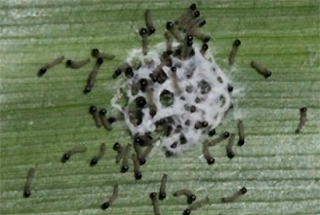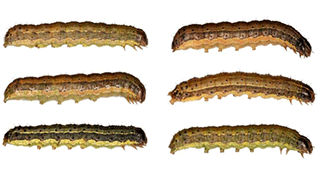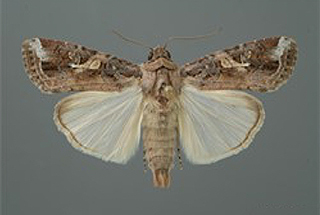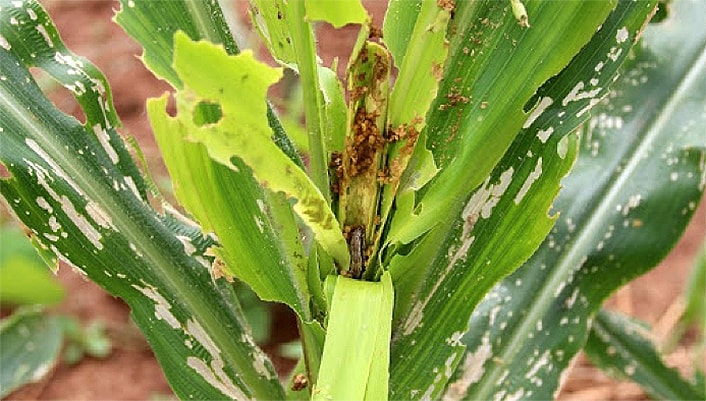Fall armyworm
A newly established pest to Australia
Fall armyworm is a highly invasive pest that has recently become established in Australia.
Fall armyworm (FAW), Spodoptera frugiperda, is a highly invasive and destructive caterpillar native to tropical and subtropical regions of the Americas. (Figure 1).

Left unchecked, numbers can increase quickly due to abundance of suitable host plants, fast reproductive cycle and ability to disperse long distances.
Destruction of crops can happen almost overnight when population levels are high.
Since 2016 FAW has spread quickly through Africa, the Indian subcontinent, China and south-east Asia.
In January 2020 it was detected in far north Queensland and has since been found in northern Western Australia and the Northern Territory. In September 2020, it was detected in a FAW surveillance trap near Moree in northern New South Wales. In December 2020 FAW was found at a single location in East Gippsland in Victoria. It is now considered established in Australia.
Despite multiple attempts, FAW has never been successfully eradicated from any country it has invaded.
Does fall armyworm occur in Victoria?
Yes, FAW is considered present in Victoria.
FAW generally prefers tropical and subtropical climates, which does not match the climate of Victoria’s production regions. It is not yet known if FAW will be able to persist over winter
Given the ability of FAW to travel long distances, there is potential for incursions into Victoria from the northern states, most likely during warmer months (summer/autumn). It is not yet known if FAW will be able to establish in Victoria.
What to look for
Eggs are laid on the underside of leaves in masses of 100-300 usually with a protective cover of fine bristles (Figure 2).

Newly hatched larvae (caterpillars) are 1mm long, pale greenish with a black head (Figure 3).

Mature caterpillars are smooth bodied and grow up to 40mm in length. They range in colour from dark yellow to green, brown and black with prominent lighter stripes running the length of the body (Figure 4).

Adults
Adults are dull brown and grey in colour with a large furry body and a wingspan of 32–40mm.
The male has two distinct white marks on each of the forewings (Figure 5 and 6).
FAW has a similar appearance to other armyworm species found in Victoria. The caterpillar can be distinguished by the inverted Y shape on the head.
The male adult has distinctive marks on the forewings and both adult sexes have iridescent white hind wings with narrow dark borders.


Impact of fall armyworm
FAW is known to feed on more than 350 plant species, including economically important crops such maize, cotton, rice, sorghum, sugarcane, wheat and many other vegetable and fruit crops.
Young caterpillars feed on leaves, creating pinholes and windows in leaf tissue, and giving leaf margins a tattered appearance.
Mature caterpillars can cause extensive defoliation and damage grazing on leaves stems and trunk and tunneling in to feed on fruit (Figure 7).
Many caterpillars may be present on one plant. If over-crowding occurs they will disperse en masse by 'marching' in search of food (hence the name 'armyworm').
Fall armyworm larvae are most active during late summer and early autumn months.
How does it spread?
Adults are capable of flying long distances and their migration rate is remarkably fast. They can also spread through trade and transport routes and people movement.
What do I do if I find fall armyworm?

Monitor your crops. Look for egg masses, plant leaf damage and fruit or vegetable damage.
Get informed. For more information about FAW in Australia please take the time to look at the experience of monitoring and managing FAW from other states and industry perspectives.
Control
FAW development and behaviour in the Victorian climate is not known to date. Issues such as whether FAW will persist through winter in Victoria, or migrate seasonally from warmer northern states, will influence control strategies. Economic thresholds for control are an area of current research.
The use of chemical control is an option where economic damage can be prevented. For information on currently registered and or permitted insecticides to manage FAW, check the Australian Pesticide and Veterinary Medicine Authority (APVMA) website.
Beneficial insects can be prevented from becoming effective at reducing pest populations if broad spectrum insecticides are used in the production system.
To ensure safe and integrated pest management, consult a qualified agronomist for advice on chemical options that may include ‘softer’ options that will reduce harm to beneficials in your production system.
Reporting an unusual plant insect pest or disease
Report any unusual plant pest or disease immediately using our online reporting form or by calling the Exotic Plant Pest Hotline on 1800 084 881. Early reporting increases the chance of effective control and eradication.
Please take multiple good quality photos of the pests or damage to include in your report where possible, as this is essential for rapid pest and disease diagnosis and response.
Your report will be responded to by an experienced staff member, who may seek more information about the detection and explain next steps.
Report onlinePhoto credits
Figure 1. FAO
Figure 2. James Castner, University of Florida
Figure 3. Pat Porter, Texas A&M
Figure 4. Agricultural Research Council, Roodeplaat, South Africa
Figure 5. Lyle Buss, University of Florida
Figure 6. Kansas State Entomology, K-State Uni
Figure 7. G. Goergen.